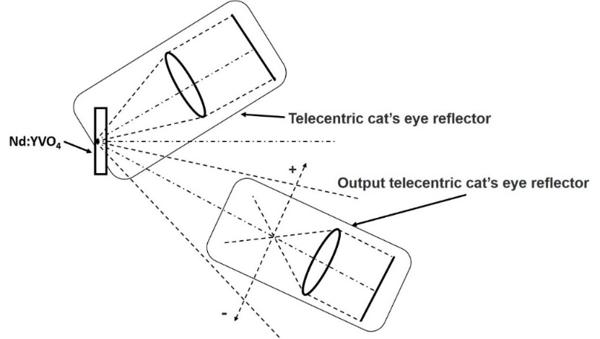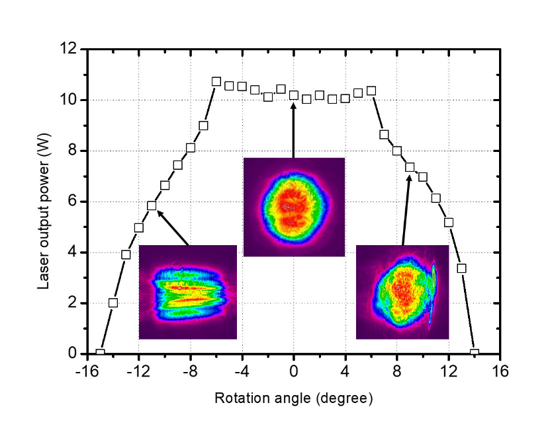The resonator is an important part of the laser oscillator. In general, it is very difficult to make a laser work ideally because it is quite difficult to adjust the two end mirrors of the resonator to a completely parallel state. Besides, when the cavity mirror of the resonator is slightly disturbed, the output of the laser will fluctuate greatly, even disappear. For all conventional plane-plane, plane-concave and concave-concave cavity lasers, these problems are inevitable. Poor prisms or cube-corner prisms have been used as the reflector of the laser resonator to improve the stability of the laser. In addition to alignment and power stability issues, the development of the movable resonator has special application values. The resonant beam charging (RBC) is a wireless power transfer technology which transfers power through the intra-cavity resonant beam. The mobility of the resonant cavity is the premise of the resonant beam charging system to realize the movable wireless power transmission. For the resonant beam charging system, the transmission power and efficiency when the output mirror moves along the axis of the resonant cavity have been demonstrated. However, the mobility of the resonant beam charging system along the horizontal direction needs further study.
The telecentric cat's eye reflector is composed of a convex lens and a plane mirror. The distance between the convex lens and the plane mirror is equal to the focal length of the convex lens. Obviously, normal incident paraxial beam will be reflected by the telecentric cat's eye reflector along the entrance way. Even for oblique incident light beam, the telecentric cat's eye reflector can provide high parallelism for the incident and the reflected beam, which is impossible for traditional laser resonator mirror. Therefore, when the telecentric cat's eye reflector is used as a resonator mirror, if there is tiny disturbance which sways the mirror for a small angle, this advantage can help reduce the negative influence. In other words, the telecentric cat's eye reflector can achieve the adjustable-free function.
The research group led by Prof. Xiaoyan Liang from Shanghai Institute of Optics and Fine Mechanics, Chinese Academy of Sciences demonstrated an adjustable-free and movable Nd:YVO4 thin disk laser based on the telecentric cat's eye cavity, relevant research results published in Chinese Optics Letters 2021, Volume 19, Issue 11 (Wei Wang, et al. Adjustable-free and movable Nd:YVO4 thin disk laser based on the telecentric cat's eye cavity).
A series of comparative experiments are conducted based on the traditional plane-plane cavity, plane-telecentric cat's eye cavity, and double telecentric cat's eye cavity. The traditional alignment problem has been well solved and the adjustable-free range is greatly improved. Besides, the resonator based on the double telecentric cat's eye can achieve horizontal mobile alignment.

Fig.1 Schematic of double telecentric cat's eye cavity
They proved that the double telecentric cat's eye cavity laser with large adjustable-free and movable range. The experimental results from the traditional plane-plane cavity, plane-telecentric cat's eye cavity, and double telecentric cat's eye cavity are compared, as shown in Figure 2. The results show that plane-telecentric cat's eye cavity laser can keep operating at the adjustable-free range of -6 degrees to +6 degrees, which is up to 60 times better than traditional plane-plane cavity. And in the double telecentric cat's eye case, the adjustable-free range is improved to -13 degrees to +13 degrees. Additionally, in the case of the double telecentric cat's eye cavity, the output telecentric cat's eye can achieve free movement within the horizontal range of ±20 mm. These advantages provide directions for applications on mobile wireless power transmission and more stable solid-state lasers.

Fig. 2 Laser output power versus rotation angle in double telecentric cat's eye cavity
It lays the foundation for achieving the mobility of the resonant beam charging system. Generally, when the resonant cavity is not optimized, the output beams are multi-mode. All the output beams in these several lasers are not optimized, so it is possible to obtain single mode output beams with good beam quality after optimizing. The achievement of Nd:YVO4 thin disk laser based on the telecentric cat's eye cavity is adjustable-free and movable. In addition, they will strive to achieve simultaneous output of multiple terminals in the future.


